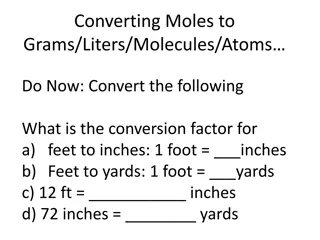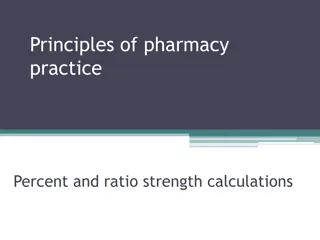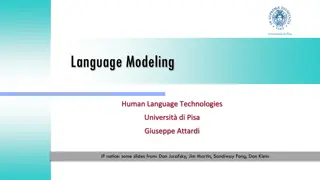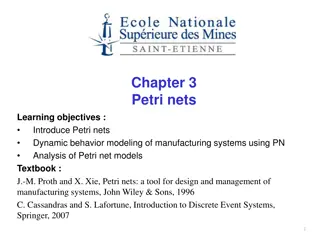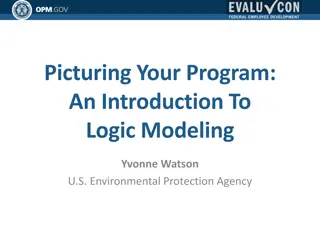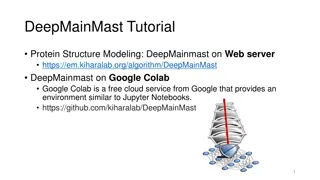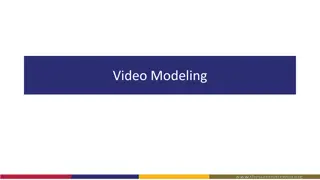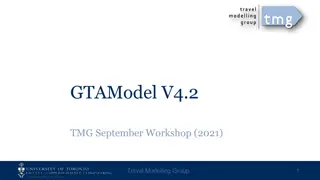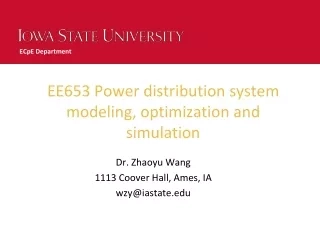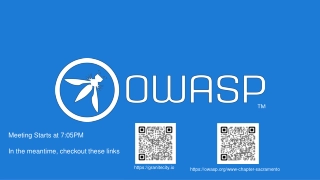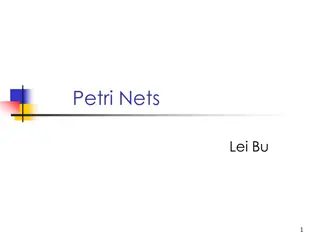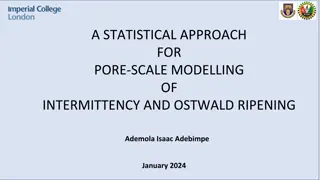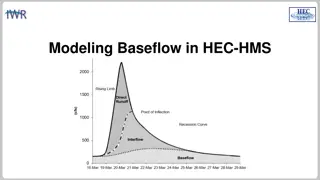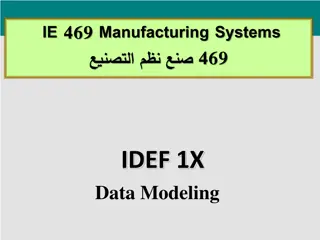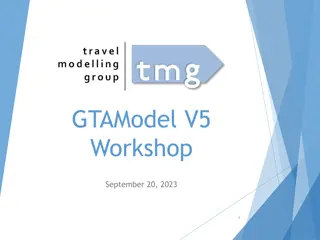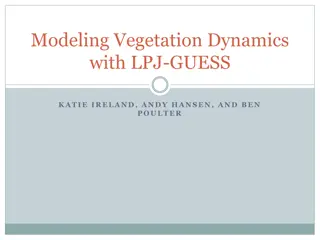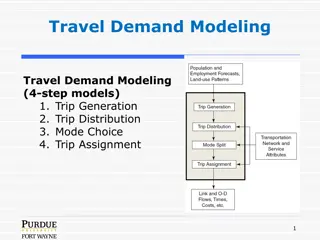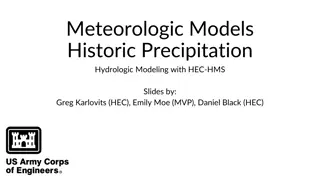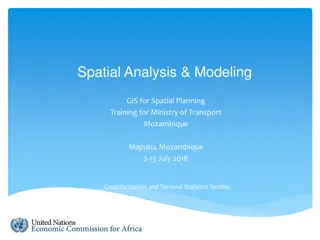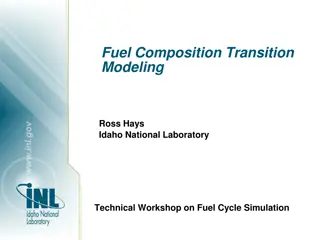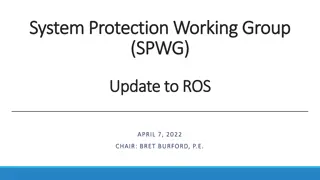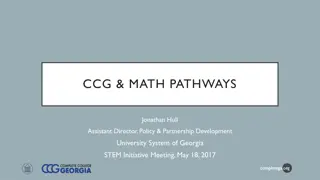Introduction to N-grams and Language Modeling
Language modeling is essential for tasks like machine translation, spell correction, speech recognition, summarization, and question-answering. Dan Jurafsky explains the goal of assigning probabilities to sentences, computing the probability of word sequences, and applying the Chain Rule to compute joint probabilities in language modeling. Estimating these probabilities involves challenges due to the vast number of possible sentences.
Download Presentation

Please find below an Image/Link to download the presentation.
The content on the website is provided AS IS for your information and personal use only. It may not be sold, licensed, or shared on other websites without obtaining consent from the author. Download presentation by click this link. If you encounter any issues during the download, it is possible that the publisher has removed the file from their server.
E N D
Presentation Transcript
Language Modeling Introduction to N-grams
Dan Jurafsky Probabilistic Language Models Today s goal: assign a probability to a sentence Machine Translation: P(high winds tonite) > P(large winds tonite) Spell Correction The office is about fifteen minuets from my house P(about fifteen minutes from) > P(about fifteen minuets from) Speech Recognition P(I saw a van) >> P(eyes awe of an) + Summarization, question-answering, etc., etc.!! Why?
Dan Jurafsky Probabilistic Language Modeling Goal: compute the probability of a sentence or sequence of words: P(W) = P(w1,w2,w3,w4,w5 wn) Related task: probability of an upcoming word: P(w5|w1,w2,w3,w4) A model that computes either of these: P(W) or P(wn|w1,w2 wn-1) is called a language model. Better: the grammar But language model or LM is standard
Dan Jurafsky How to compute P(W) How to compute this joint probability: P(its, water, is, so, transparent, that) Intuition: let s rely on the Chain Rule of Probability
Dan Jurafsky Reminder: The Chain Rule Recall the definition of conditional probabilities p(B|A) = P(A,B)/P(A) Rewriting: P(A,B) = P(A)P(B|A) More variables: P(A,B,C,D) = P(A)P(B|A)P(C|A,B)P(D|A,B,C) The Chain Rule in General P(x1,x2,x3, ,xn) = P(x1)P(x2|x1)P(x3|x1,x2) P(xn|x1, ,xn-1)
The Chain Rule applied to compute joint probability of words in sentence Dan Jurafsky i P(w1w2 wn) = P(wi|w1w2 wi-1) P( its water is so transparent ) = P(its) P(water|its) P(is|its water) P(so|its water is) P(transparent|its water is so)
Dan Jurafsky How to estimate these probabilities Could we just count and divide? P(the |its water is so transparent that) = Count(its water is so transparent that the) Count(its water is so transparent that) No! Too many possible sentences! We ll never see enough data for estimating these
Dan Jurafsky Markov Assumption Simplifying assumption: Andrei Markov P(the |its water is so transparent that) P(the |that) Or maybe P(the |its water is so transparent that) P(the |transparent that)
Dan Jurafsky Markov Assumption i P(w1w2 wn) P(wi|wi-k wi-1) In other words, we approximate each component in the product P(wi|w1w2 wi-1) P(wi|wi-k wi-1)
Dan Jurafsky Simplest case: Unigram model i P(w1w2 wn) P(wi) Some automatically generated sentences from a unigram model fifth, an, of, futures, the, an, incorporated, a, a, the, inflation, most, dollars, quarter, in, is, mass thrift, did, eighty, said, hard, 'm, july, bullish that, or, limited, the
Dan Jurafsky Bigram model Condition on the previous word: P(wi|w1w2 wi-1) P(wi|wi-1) texaco, rose, one, in, this, issue, is, pursuing, growth, in, a, boiler, house, said, mr., gurria, mexico, 's, motion, control, proposal, without, permission, from, five, hundred, fifty, five, yen outside, new, car, parking, lot, of, the, agreement, reached this, would, be, a, record, november
Dan Jurafsky N-gram models We can extend to trigrams, 4-grams, 5-grams In general this is an insufficient model of language because language has long-distance dependencies: The computer which I had just put into the machine room on the fifth floor crashed. But we can often get away with N-gram models
Language Modeling Introduction to N-grams
Language Modeling Estimating N-gram Probabilities
Dan Jurafsky Estimating bigram probabilities The Maximum Likelihood Estimate P(wi|wi-1)=count(wi-1,wi) count(wi-1) P(wi|wi-1)=c(wi-1,wi) c(wi-1)
Dan Jurafsky An example <s> I am Sam </s> <s> Sam I am </s> <s> I do not like green eggs and ham </s> P(wi|wi-1)=c(wi-1,wi) c(wi-1)
Dan Jurafsky More examples: Berkeley Restaurant Project sentences can you tell me about any good cantonese restaurants close by mid priced thai food is what i m looking for tell me about chez panisse can you give me a listing of the kinds of food that are available i m looking for a good place to eat breakfast when is caffe venezia open during the day
Dan Jurafsky Raw bigram counts Out of 9222 sentences
Dan Jurafsky Raw bigram probabilities Normalize by unigrams: Result:
Dan Jurafsky Bigram estimates of sentence probabilities P(<s> I want english food </s>) = P(I|<s>) P(want|I) P(english|want) P(food|english) P(</s>|food) = .000031
Dan Jurafsky What kinds of knowledge? P(english|want) = .0011 P(chinese|want) = .0065 P(to|want) = .66 P(eat | to) = .28 P(food | to) = 0 P(want | spend) = 0 P (i | <s>) = .25
Dan Jurafsky Practical Issues We do everything in log space Avoid underflow (also adding is faster than multiplying) log(p1 p2 p3 p4)=logp1+logp2+logp3+logp4
Dan Jurafsky Language Modeling Toolkits SRILM http://www.speech.sri.com/projects/srilm/ KenLM https://kheafield.com/code/kenlm/
Dan Jurafsky Google N-Gram Release, August 2006
Dan Jurafsky Google N-Gram Release serve as the incoming 92 serve as the incubator 99 serve as the independent 794 serve as the index 223 serve as the indication 72 serve as the indicator 120 serve as the indicators 45 serve as the indispensable 111 serve as the indispensible 40 serve as the individual 234 http://googleresearch.blogspot.com/2006/08/all-our-n-gram-are-belong-to-you.html
Dan Jurafsky Google Book N-grams http://ngrams.googlelabs.com/
Language Modeling Estimating N-gram Probabilities
Evaluation and Perplexity Language Modeling
How to evaluate N-gram models "Extrinsic (in-vivo) Evaluation" To compare models A and B 1. Put each model in a real task Machine Translation, speech recognition, etc. 2. Run the task, get a score for A and for B How many words translated correctly How many words transcribed correctly 3. Compare accuracy for A and B
Intrinsic (in-vitro) evaluation Extrinsic evaluation not always possible Expensive, time-consuming Doesn't always generalize to other applications Intrinsic evaluation: perplexity Directly measures language model performance at predicting words. Doesn't necessarily correspond with real application performance But gives us a single general metric for language models Useful for large language models (LLMs) as well as n-grams
Training sets and test sets We train parameters of our model on a training set. We test the model s performance on data we haven t seen. A test set is an unseen dataset; different from training set. Intuition: we want to measure generalization to unseen data An evaluation metric (like perplexity)tells us how well our model does on the test set.
Choosing training and test sets If we're building an LM for a specific task The test set should reflect the task language we want to use the model for If we're building a general-purpose model We'll need lots of different kinds of training data We don't want the training set or the test set to be just from one domain or author or language.
Training on the test set We can t allow test sentences into the training set Or else the LM will assign that sentence an artificially high probability when we see it in the test set And hence assign the whole test set a falsely high probability. Making the LM look better than it really is This is called Training on the test set Bad science! 33
Dev sets If we test on the test set many times we might implicitly tune to its characteristics Noticing which changes make the model better. So we run on the test set only once, or a few times That means we need a third dataset: A development test set or, devset. We test our LM on the devset until the very end And then test our LM on the test set once
Intuition of perplexity as evaluation metric: How good is our language model? Intuition: A good LM prefers "real" sentences Assign higher probability to real or frequently observed sentences Assigns lower probability to word salad or rarely observed sentences?
Intuition of perplexity 2: Predicting upcoming words time 0.9 The Shannon Game: How well can we predict the next word? Once upon a ____ That is a picture of a ____ For breakfast I ate my usual ____ dream 0.03 midnight 0.02 and 1e-100 Unigrams are terrible at this game (Why?) Claude Shannon A good LM is one that assigns a higher probability to the next word that actually occurs Picture credit: Historiska bildsamlingen https://creativecommons.org/licenses/by/2.0/
Intuition of perplexity 3: The best language model is one that best predicts the entire unseen test set We said: a good LM is one that assigns a higher probability to the next word that actually occurs. Let's generalize to all the words! The best LM assigns high probability to the entire test set. When comparing two LMs, A and B We compute PA(test set) and PB(test set) The better LM will give a higher probability to (=be less surprised by) the test set than the other LM.
Intuition of perplexity 4: Use perplexity instead of raw probability Probability depends on size of test set Probability gets smaller the longer the text Better: a metric that is per-word, normalized by length Perplexity is the inverse probability of the test set, normalized by the number of words -1 PP(W) = P(w1w2...wN) N 1 = N P(w1w2...wN)
Intuition of perplexity 5: the inverse inverse Perplexity is the inverse probability of the test set, normalized by the number of words -1 PP(W) = P(w1w2...wN) N 1 = N P(w1w2...wN) (The inverse comes from the original definition of perplexity from cross-entropy rate in information theory) Probability range is [0,1], perplexity range is [1, ] Minimizing perplexity is the same as maximizing probability
Intuition of perplexity 6: N-grams -1 PP(W) = P(w1w2...wN) N 1 = N P(w1w2...wN) Chain rule: Bigrams:
Intuition of perplexity 7: Weighted average branching factor Perplexity is also the weighted average branching factor of a language. Branching factor: number of possible next words that can follow any word Example: Deterministic language L = {red,blue, green} Branching factor = 3 (any word can be followed by red, blue, green) Now assume LM A where each word follows any other word with equal probability Given a test set T = "red red red red blue" PerplexityA(T) = PA(red red red red blue)-1/5 = (( )5)-1/5= ( )-1 =3 But now suppose red was very likely in training set, such that for LM B: P(red) = .8 p(green) = .1 p(blue) = .1 We would expect the probability to be higher, and hence the perplexity to be smaller: PerplexityB(T) = PB(red red red red blue)-1/5 = (.8 * .8 * .8 * .8 * .1) -1/5 =.04096 -1/5 = .527-1 = 1.89
Holding test set constant: Lower perplexity = better language model Training 38 million words, test 1.5 million words, WSJ N-gram Order Perplexity 962 Unigram Bigram Trigram 170 109
Evaluation and Perplexity Language Modeling
Sampling and Generalization Language Modeling
The Shannon (1948) Visualization Method Sample words from an LM Claude Shannon Unigram: REPRESENTING AND SPEEDILY IS AN GOOD APT OR COME CAN DIFFERENT NATURAL HERE HE THE A IN CAME THE TO OF TO EXPERT GRAY COME TO FURNISHES THE LINE MESSAGE HAD BE THESE. Bigram: THE HEAD AND IN FRONTAL ATTACK ON AN ENGLISH WRITER THAT THE CHARACTER OF THIS POINT IS THEREFORE ANOTHER METHOD FOR THE LETTERS THAT THE TIME OF WHO EVER TOLD THE PROBLEM FOR AN UNEXPECTED.
How Shannon sampled those words in 1948 "Open a book at random and select a letter at random on the page. This letter is recorded. The book is then opened to another page and one reads until this letter is encountered. The succeeding letter is then recorded. Turning to another page this second letter is searched for and the succeeding letter recorded, etc."
Visualizing Bigrams the Shannon Way Choose a random bigram (<s>, w) <s> I I want want to to eat eat Chinese Chinese food food </s> I want to eat Chinese food according to its probability p(w|<s>) Now choose a random bigram (w, x) according to its probability p(x|w) And so on until we choose </s> Then string the words together
Note: there are other sampling methods Used for neural language models Many of them avoid generating words from the very unlikely tail of the distribution We'll discuss when we get to neural LM decoding: Temperature sampling Top-k sampling Top-p sampling



